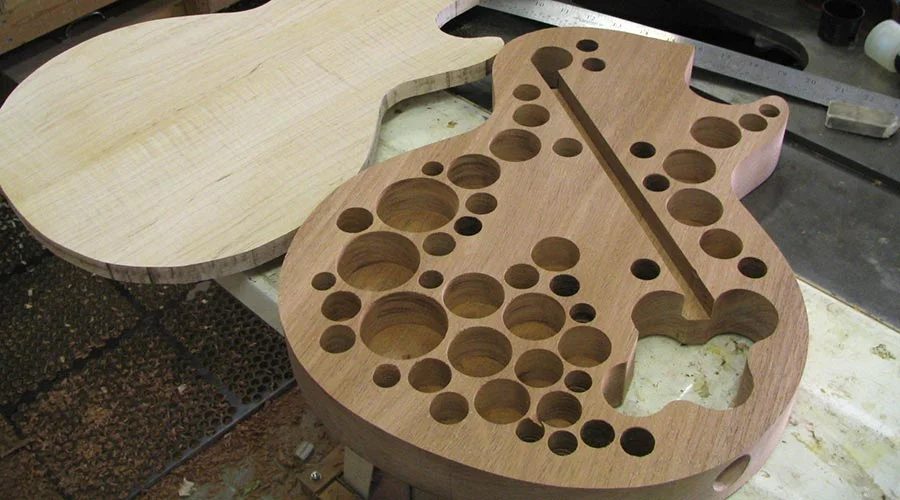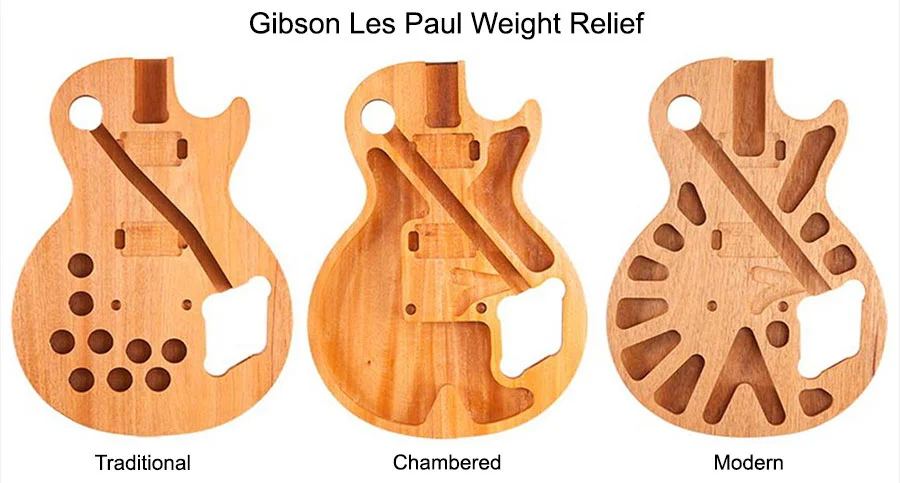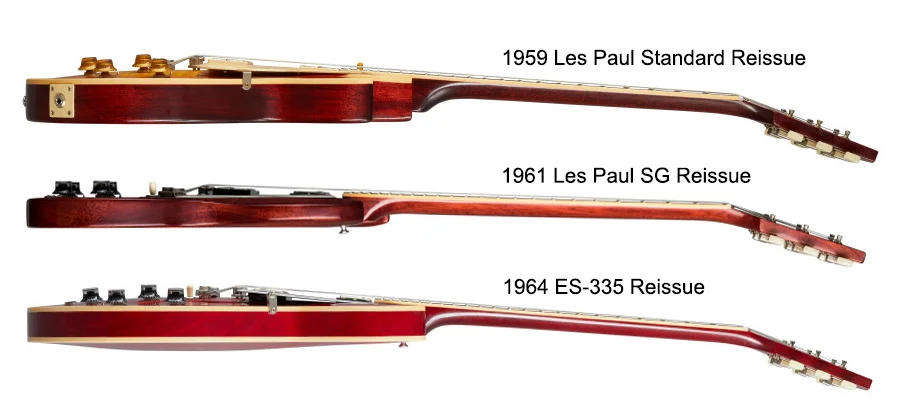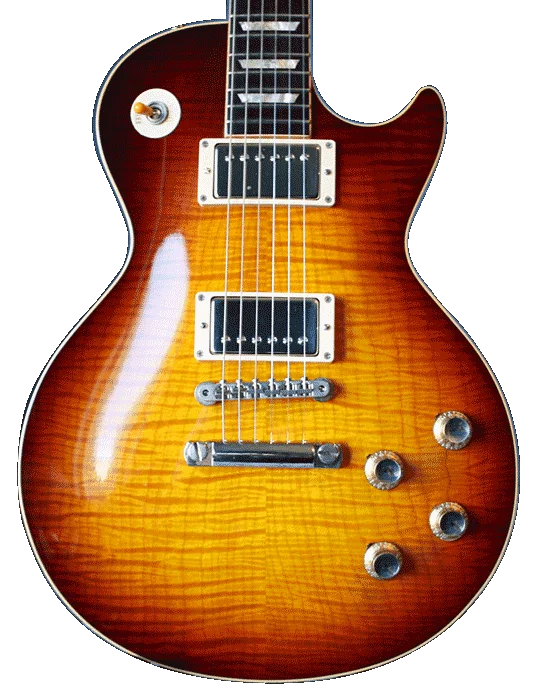
You have just finished a big show, you sounded great, and the band rocked. You were stood at the front, 6ft tall with your Les Paul slung low. You looked amazing. But…by the end of the gig, you hobbled off the stage feeling more like 5′ 8″!
Anyone who has ever played a 2-hr gig with a Les Paul guitar will know they can be heavy. If you want the tone, then you’ve got to put up with the weight. You have got to suffer for your art, right? Well, yes and no. Thing is, not all Les Paul’s are created equal, some can weigh 8 lbs, and some weigh 14 lbs.
What’s the deal, how can the same guitar vary so much? Well, the aim of this article is to explain just that. What makes the weight differ, how the era in which it was built was a factor, and whether the difference in weight has any influence on tone.
The Golden Age: 1958-1960
Ok, before anyone starts to soil their underpants, I know that the Gibson Les Paul was first introduced to the world in 1952, but for simplicity’s sake, I am going to start with the ‘bursts, like the 1959 Gibson Les Paul. I think this is what most of us think of when we imagine a Les Paul.
Construction
The first thing to get an understanding of is the construction.
When Ted McCarty and Les Paul got together to create Gibson’s first solidbody electric guitar, it was clear that the instrument had to be made of solid wood…hence, you know, solidbody. The reason this was so important was to eliminate the feedback that had been such an issue with the hollow and semi-hollow designs of the day. Les had initially pushed for an all-maple design but this was deemed to be too heavy and so it was decided the guitar would be a solid mahogany body and neck with a maple cap and a rosewood fingerboard. It is this relatively simple recipe that gives the Les Paul its heft and the legendary sound too.
The Les Paul differed from its main rivals, namely the Fender Telecaster and the Stratocaster because of the addition of the maple cap. It is said this extra ½ inch thick piece of wood was added to complement the warmer sound of mahogany by giving it some extra bite. In addition to the tonal benefits the mahogany/maple sandwich added to the new design, Gibson wanted to further differentiate itself from Fender by carving the top. All this extra wood meant that the guitar became heavier.
Weight
We have seen that the Les Paul has more wood in comparison to the other electric guitars of the day and that it was for tonal reasons as well as cosmetic.
Now let’s have a look at the typical weight of these original Gibson Les Pauls. These days, retailers will list the weight of individual guitars, but in the 1950s guitarists were more interested in playing them than putting them on a set of scales. I know…crazy. Luckily, we have the Les Paul bible: Yashuhiko Iwanade’s “The Beauty of the Burst” for reference. It contains a table of the weights and thicknesses of 50 original ‘burst guitars, the weights range from 8 lb 1.4 oz to 9 lb 11.4 oz. So even in the beginning, the weight varied by quite a lot, but I think it is safe to say that the original Les Paul was in the 8-9 lb range A quick calculation puts the average of all these guitars at 8 lb 8 oz. This variation in weight does not correlate to different build years but it is mostly down to the differences in the weight of the mahogany. More on this later.
The Norlin Years: 1969-1986
This is when things start to get interesting.
In 1969, Gibson’s parent company Chicago Musical Instruments was sold to an Ecuadorian brewing company. Eventually, it came to be known as Norlin. During this era, many changes were made to the way the Les Paul was made, and the lore that surrounds these changes has become infamous. Was it cost-cutting? Was it to improve the guitar? There will never be a definitive answer to these questions, but they absolutely affected the original design and the weight of the instrument.
Construction
The first major change that Norlin made to the Les Paul was the notorious pancake body. This involved splitting the mahogany body and sandwiching a thin layer of maple in between, this was topped off with the usual maple cap. According to Gibson/Norlin, the reason for this was to strengthen the body of the guitar, but it may also have allowed for thinner body blanks to be used thus cutting costs. This lasted from 1969-1973 when customer complaints and labor costs put a stop to it.
Norlin also changed the construction of the neck. In 1969, the Les Paul went from having a one-piece mahogany neck to a three-piece, laminated mahogany neck, and in 1974 to a three-piece maple neck. The reasoning behind this radical design shift was to strengthen the neck, but in addition to creating a more robust instrument for the player, it also cut down on costs incurred due to customer returns. A volute was also added where the headstock meets the neck. This further strengthened a notorious weak spot. When you add all these structural changes to the three-piece top that had also been adopted, it was clear the Les Paul had deviated from the original by quite a bit.
Weight
So, what did all these changes do to the weight of the Les Paul? Well, they made it heavier. A guitar is a sum of its parts, and it all adds up, but this isn’t the main reason that the Norlin-era Les Pauls are often referred to as “boat anchors”.
No, that would be down to the weight of the mahogany. There is a debate, a very controversial subject that you enter at your peril! How old is your wood? It has grown men frothing at the mouth, furiously hammering away on keyboards telling anyone and everyone that they are right, and the rest of the world are morons. The argument about old-growth wood vs new-growth is beyond the scope of this article but I will at least try to outline it.
When a tree grows, the base of it is the strongest, most dense part. This provides the strength to allow the tree to survive as it grows upwards. At the top, the wood is the lightest, and this prevents the tree from being top-heavy and breaking. So far, so good. The argument goes that if the tree grows slowly over its lifetime the wood at the top retains the acoustic properties of the base while being naturally lighter. When Gibson sourced the wood that they needed to build the original Les Pauls, they went to trees that had grown slowly over hundreds of years, and they selected the light and resonant mahogany from the top of the tree. This is what gave the originals that legendary sound. By the time the Les Paul went back into production in 1968, this wood was not readily available and they were forced to use the heavier wood from lower down in the tree.
What is undeniable is that the Norlin Les Pauls are heavier than the original guitars. The question is whether it was by design or due to circumstances surrounding available wood? Anecdotal evidence suggests that, in fact, heavier Les Paul’s were preferred by many in the 1970s as it was said to give the instrument better sustain. Others have maintained it was purely down to Norlin’s cost-cutting by refusing to source the best mahogany. The debate will rage on regardless, but it is interesting to note that in recent years, Norlin Les Pauls have seen somewhat of a reappraisal and are now more appreciated as the plucky underdog to their predecessors. So, if you think you can handle a 14 lb guitar then you might be pleasantly surprised. Oh yeah, and they can rock too!
The Henry J Era: 1986-2017
In 1986, Gibson changed hands once more, this time it was bought by three businessmen: Henry E. Juszkiewicz, David H. Berryman, and Gary A. Zebrowski. Gibson had already started to realize that their heritage was worth preserving and had been attempting to recreate the classic Les Paul in earnest since the Heritage models in 1980. Henry gradually developed this idea of bringing the Les Paul back to its original specs. But what to do about the weight?
Construction
The Les Paul was now back to the classic design of a mahogany body and neck, with a maple cap and a rosewood fingerboard, but there was something else going on under the hood that went undetected for some time.
The story goes that one day someone was going through airport check-in when they noticed something strange. As their Les Paul was passing through the x-ray machine, they see holes in the body that resembled Swiss cheese. What was going on?! Well, it turned out that since 1983 Gibson had been removing some of that super-heavy mahogany in a process that would become known as weight relief. Is the airport story true? Who knows but weight relief continues to this day.

Weight
So, what exactly is weight relief, and does it work?
Traditional Weight Relief
The process involves removing wood from the body of the guitar, the original process was to rout out 9 holes on the lower bout of the guitar, opposite the control cavity. This is now known as traditional weight relief or “Swiss cheese”. This process has been used on most USA Les Pauls from 1983 up until around 2008. It is still used on the Les Paul Custom.
Chambered
This was introduced by Gibson in 2006 and lasted until 2012. It takes the 9-hole relief even further by chambering out most of the body and almost making the guitar a semi-acoustic model. The effect on the weight is dramatic but it can be argued that it is a step too far for the traditionalists.
Modern Weight Relief
This is somewhere in between. The body has less severe chambered sections, leaving much more of the body intact. This was introduced in 2012 and can still be found on some models.
Ultra-Modern Weight Relief
This one is a bit harder to quantify as there are no pictures of it online. It is said to be like modern weight relief, but more strategically placed so as not to negatively affect the tone in any way.

Gibson Today
To answer the original question: What is weight relief, and does it work?
These are the 4 methods that Gibson uses when it tries to make the Les Paul a lighter guitar, and it works, but at what price? It is difficult to say. For some, a little bit less weight is no bad thing, and if it means someone can enjoy playing their instrument for years to come, then that has to be positive. For the traditionalist, it is heresy.
Luckily Gibson now offers something for everyone.
In 2018 after filing for bankruptcy, Gibson was taken over by a hedge fund, KKR with JC Curleigh at the helm. After some missteps towards the end of Henry J’s reign, the modern company seems to have a firm grip on its heritage and has been offering the most accurate reproductions of the Les Paul since Ted McCarty’s time.
Do you want a no-nonsense Les Paul made like the old days? Gibson Les Paul Standard 50s or 60s is the answer. Solid mahogany and maple.
What about something a bit easier on the shoulders? Les Paul Modern. Ultra-modern weight relief, contoured heel, push-pull pots, and a compound radius fretboard.
Custom Shop Reissues
As it was in the beginning, so shall it be in the end…
The pinnacle of the Les Paul experience is still the original design and after the initial missteps of the 80’s reissues, Gibson is now creating guitars that are as close to the golden age as possible.
These reissues have a one-piece solid mahogany body and neck, a rosewood fingerboard, and a maple cap. The body blanks are specially selected according to weight, ensuring the finished instrument weighs the same as the originals.
How is this achievable? Ultimately by compromising on the mahogany used, as old-growth wood is no longer an option, faster-growing timber is used. Some may argue that it doesn’t retain the original properties of the old growth, but short of finding a hidden forest, it is the only option available to Gibson. Unless you have a time-traveling Delorean or half a million, this is as close as you are going to get.
How thick is a Les Paul body?
Up until this point, we have been looking at the Les Paul Standard, but Gibson offers several models at various price points. One of the differences throughout the range is body thickness, which changes the weight. Here is a list of the current Les Paul models, their body thicknesses, and an approximation of weight.
Gibson USA Les Paul Tribute
This is an entry-level LP; it has ultra-modern weight relief and so it is a light guitar. Mahogany body and neck with a maple cap, although a slightly thinner one than a Standard. Expect them to weigh 8-9 lbs.
Gibson USA Les Paul Junior
This is the single pickup (P90) Les Paul that was originally designed as a student model. It is now a cult classic. It is a plain slab of mahogany, uncarved and unadorned with any bling. This guitar does not have a maple cap, so straight away it is missing that ½” thick piece of wood. Expect them to be in the 7-8lb range. No weight relief.
Gibson USA Les Paul Studio
Like the Tribute, except for the finish, is a gloss nitro instead of satin nitro. They are both 1/8″ thinner than a Standard, have no binding, and have ultra-modern weight relief. Again, usually in the 8-9 lbs weight range.
Gibson USA Les Paul Special
This is basically a 2-pickup version of the Junior. A single piece of mahogany, no maple, with two P90s and a rosewood board. Typically, 7-8 lbs. No weight relief.
Gibson USA Les Paul Classic
As the name suggests this guitar takes its inspiration from the past. This is Les Paul Standard but with 3 differences: It has push-pull pots allowing for single coil sounds, it has uncovered pickups which is of particular interest here, and it has traditional 9-hole weight relief. If it’s an old-school Les Paul you are after but a pound or 2 lighter, and with coil splits this is it. They are the same thickness as a standard (roughly 1.8 inches (47mm)) and are normally in the 9-10 lb range.
Gibson USA Les Paul Modern
This is the Standard but with modern features. Mahogany body and neck, maple cap but an ebony fretboard. It has a myriad of switching options with each pot having a push-pull function and crucially ultra-modern weight relief. This guitar is extensively weight relieved, and it offers the player the lightest, USA full-body Les Paul on the market. Expect these to weigh 8-9 lbs.
Gibson USA Les Paul Standard
Now we get to the flagship Les Paul: The Standard. If you have gotten this far, you know the construction, and this guitar is a modern version of the original. It has no weight relief so it can be heavy, but if you’re prepared to go searching, lighter guitars are out there. Regardless of weight, this has all the classic sounds and gorgeous looks. They are roughly 1.8 inches (47mm) thick. Typically, these will weigh anything between 9 and 11 lbs.
Gibson Les Paul Custom
This is the thickest feeling of all the Les Paul models. Usually, they will be a mahogany and maple body but originally, they were solid mahogany. They are bound on the back and front, so this gives them a slightly chunkier feel, although they are the same thickness as a Standard. They have traditional 9-hole weight relief but are still known to be weighty. Expect anything between 9-11 lbs.
Gibson Custom Shop Reissue (1958-1960)
These are clones of the original guitars with specially selected woods and no weight relief. They are ever so slightly thinner than a USA standard as per the original spec. They will almost always be lighter than a USA standard. Expect them to weigh between 8 and 9 lbs.

Final Thoughts on Les Paul Weight
Why do we even care about this stuff?
Everybody wants something different out of their Les Paul. Some people want as close to the original as possible, so only an 8-9 lb guitar will cut the mustard. Others crave the thick, meaty sound that they believe only a heavy guitar can provide. Some people just want a modern guitar that they can play for a couple of hours without slipping a disc.
Because the original ‘bursts created such an indelible mark on guitar history, their specs will always be the most desirable. But, as we have seen, every era has its own thing going on.
Luckily, these days you can get any kind of Les Paul you want, heavy or light, 50’s, 60s or 70’s spec.
The bottom line is: If it sounds good and feels good, it is good.
Share your thoughts in our forum! 💬
👉 Introduce yourself and show off your Les Paul and other gear.
Frequently Asked Questions
Is a Les Paul heavier than a Strat?
The average Stratocaster is 7-8 lbs so yes, on average, a Les Paul weighs more than a Strat. More wood usually equals more weight. There are outliers in both models, some Strats can be as heavy as 9 lbs and some Les Paul’s as light as 8 lbs.
How much does a Gibson SG Les Paul weigh?
The SG famously retained the Les Paul named when it was released in 1961, so what does it weigh? It is distinct for its slimmed down mahogany body, and no maple cap, so it is a lighter guitar. Typically, they will be in the 7-8 lb weight range.
Is an 8 pound Les Paul guitar heavy?
No! For many an 8 lb Les Paul is the holy grail. Many of the original ‘bursts were 8 pounders, and they are now the most sought after electric guitars on the planet.
Share this post with your friends using these one-click sharing options:
👉 Click here to share on Facebook.
👉 Click here to share on X.
👉 Click here to share on LinkedIn.

Get the latest reviews, guides and videos in your inbox.